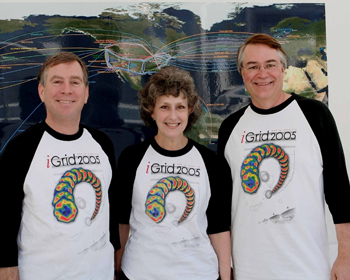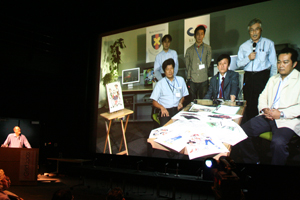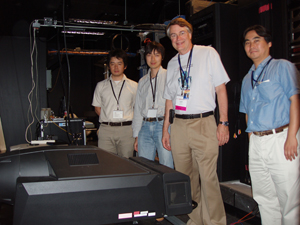iGrid 2005 Receives CENIC Networking Innovation Award
Oakland, CA, March 14, 2006 -- A demonstration of more than four dozen scientific applications running on very-high-bandwidth optical networks -- many of them linking different countries on different continents -- has won the CENIC 2006 Innovations in Networking Award for Experimental/Developmental Applications.
|
Smarr accepted the award today during the annual networking conference for researchers and educators organized by the Corporation for Education Network Initiatives in California (CENIC). The three-day conference, “Your Connection to the World,” runs through March 15 at the Marriott Oakland City Center Hotel in Oakland , CA .
The prize-winning iGrid 2005 workshop last September in San Diego was the fourth community-driven, biennial iGrid event. It was a coordinated effort to accelerate the use of multi-10-Gigabit international and national networks to advance scientific research, and to educate decision makers, academics and industry researchers on the benefits of these hybrid networks. The workshop demonstrated 48 real-time applications from 20 countries. A companion symposium featured more than 50 lectures, presentations and master classes on the applications, middleware, and underlying cyberinfrastructure making those applications possible.
“Thanks to the superlative leadership of Tom, Maxine and Larry, iGrid 2005 gave scientists and technologists a chance to push the envelope of optical networking in a very real-world environment,” said Jim Dolgonas, President of CENIC. "Grid computing over optical networks is now poised to become the foundation of tomorrow's science and innovation, and iGrid gave applications scientists an opportunity to test-drive that future."
|
“The emergence of the LambdaGrid as a global high-bandwidth optical networking infrastructure is leading e-science from a bandwidth-constrained to a bandwidth-rich world,” said iGrid 2005 host Smarr, who is also a professor of computer science and engineering at the University of California, San Diego’s Jacobs School of Engineering. “I think we are still in the pioneering phase of a LambdaGrid world, but by 2007, the research should advance sufficiently to be all about homesteading science that you can do with global LambdaGrid services, many of them first demonstrated at iGrid 2005.”
“This award is a real honor for the entire international team that worked tirelessly for years to make iGrid 2005 happen,” said UIC’s Maxine Brown. Her iGrid co-chair, Tom DeFanti, agreed, noting that “this was also the first iGrid to take place in California , and our participants witnessed first-hand the extent to which organizations such as CENIC and Calit2 are committed to keeping the State of California on the cutting edge of these transformational technologies.”
|
The Innovations in Networking award to iGrid 2005 is one of five handed out during CENIC 2006. The other categories included Educational Applications, Gigabit/Broadband Applications, High-Performance Applications, and the Outstanding Individual Contribution Award. The latter award went to David Wasley, retired Special Assistant for Information Resources and Communications, at the UC Office of the President, who was instrumental in deployment of the original CENIC network.
About iGrid
The International Grid (iGrid) biennial/triennial collaborative event showcases ongoing global collaborations in middleware development and applications research that require high-performance multi-Gigabit networks. iGrid 2005 was organized by institutions, organizations, consortia and National Research & Education Networks who also participate in the Global Lambda Integrated Facility (GLIF). Overall planning responsibilities for iGrid were handled by the Electronic Visualization Laboratory at the University of Illinois at Chicago and Calit2 at the University of California , San Diego , in cooperation with the Mathematics and Computer Science Division of Argonne National Laboratory, SURFnet, University of Amsterdam , and CANARIE. IGrid was sponsored by the U.S. National Science Foundation, CENIC, Ciena, Cisco Systems, Force10, GlimmerGlass, Globus Alliance, GRIDtoday, Looking Glass, National LambdaRail, Nortel, Qwest, Silicon Graphics Inc/James River Technical Inc, Sony, TeraGrid and the University of California (UC) Industry-University Cooperative Research Program (IUCRP) UC Discovery Grant program. http://www.igrid2005.org/
About CENIC
California ’s higher education and research communities leverage their networking resources under the umbrella of a nonprofit corporation known as CENIC, the Corporation for Education Network Initiatives in California , in order to obtain cost-effective, high-bandwidth networking to support their missions and answer the needs of their faculty, staff, and students. CENIC designs, implements, and operates CalREN, the California Research and Education Network, a high-bandwidth, high-capacity Internet network specially designed to meet the unique requirements of these communities, and to which the vast majority of the state’s K-20 educational institutions are connected. In order to facilitate collaboration in education and research, CENIC also provides connectivity to non-California institutions and industry research organizations with which CENIC’s Associate researchers and educators are engaged. CENIC is governed by its member institutions. Representatives from these institutions also donate expertise through their participation in various committees designed to ensure that CENIC is managed effectively and efficiently, and to support the continued evolution of the network as technology advances. http://www.cenic.org/
About Calit2
The California Institute for Telecommunications and Information Technology, a partnership between UC San Diego and UC Irvine, houses over 1,000 researchers organized around more than 50 projects on the future of telecommunications and information technology and how these technologies will transform a range of applications important to the economy and citizens' quality of life. http://www.calit2.net
About EVL
The Electronic Visualization Laboratory (EVL) at the University of Illinois at Chicago is a graduate research laboratory specializing in the design and development of high-resolution visualization and virtual-reality display systems, collaboration software for use on multi-gigabit networks, and advanced networking infrastructure. EVL is a joint effort of UIC's College of Engineering and School of Art and Design, and represents the oldest formal collaboration between engineering and art in the country offering graduate MS, PhD and MFA degrees. EVL has received worldwide recognition for developing the original CAVE® and ImmersaDesk® virtual reality systems; and most recently the 105-Megapixel LambdaVision tiled display and VARRIER autostereoscopic display. EVL is a founding member of StarLight and the Global Lambda Integrated Facility (GLIF), and with UCSD is a leading institution working on the NSF-funded OptIPuter project. http://www.evl.uic.edu
Related Links
CENIC
iGrid 2005
Electronic Visualization Laboratory
Related Articles
iGrid to Push Edge of Networking Frontier by Demonstrating World?s Most Demanding Applications
Media Contacts
Media Contacts:
Doug Ramsey, Calit2, (858) 822-5825, dramsey@ucsd.edu
Janis Cortese, CENIC, (714) 220-3454, jcortese@cenic.org




